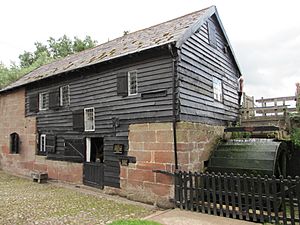Stretton Watermill facts for kids
Quick facts for kids Stretton Watermill |
|
|---|---|

Stretton Watermill
|
|
| Location | Stretton, Cheshire West and Chester |
| Built | 16th century |
| Governing body | Cheshire West and Chester Council |
|
Listed Building – Grade II*
|
|
| Designated | 18 July 1972 |
| Reference no. | 1279423 |
| Lua error in Module:Location_map at line 420: attempt to index field 'wikibase' (a nil value). | |
Stretton Watermill is a really old and interesting watermill located in Stretton, Cheshire, England. It's a special place because it still works! The local council, Cheshire West and Chester Council, takes care of it. This mill is so important that it's listed as a Grade II* building. This means it's a very important historic building that needs to be protected. Even its old machinery is considered nationally important.
Contents
The Mill's Long History
When Did Stretton Watermill Begin?
The first time anyone wrote about Stretton Watermill was way back in 1351. That's over 670 years ago! In the 1500s, a family called the Leche family owned the mill.
How the Mill Changed Over Time
The oldest parts of the mill building you can see today were built around 1630. Back then, it was made mostly of wood, like a big timber-framed house. It had one special type of waterwheel called a breastshot wheel. This wheel gets its power from water hitting it in the middle. The stone floor inside the mill might even be older than 1630!
In 1770, a man named William Leche made the mill bigger. He raised the roof and changed it from a straw roof to one made of slate tiles. The wooden frame was covered with wooden boards and stone. A new type of waterwheel, an overshot wheel, was added. This wheel works when water flows over the top of it. You can still see a stone that remembers this work on the building.
Later, in 1852, the old wooden breastshot wheel was replaced. A new one, made of strong cast iron, took its place. The mill kept working for many years, helping to grind grain into flour.
From Working Mill to Museum
Stretton Watermill stopped grinding grain in 1959. But its story didn't end there! From 1975 to 1977, two people named Cyril and John Boucher worked hard to fix the old mill machinery. They even got some help from the Science Museum. Thanks to their efforts, the mill opened as a museum in 1977. Now, people can visit and learn all about how a watermill works.
What Stretton Watermill Looks Like
Building Materials and Design
The mill building has a wooden frame inside, but it's covered on the outside with wooden boards and sandstone. There's also a part made of brick, and a chimney built from stone and brick. The roofs are all covered with slate tiles.
The mill has two main floors, plus an attic space at the very top. This attic was used for storing grain. All the windows are casement windows, which means they open outwards like a door. Some even have shutters.
The Waterwheels and Machinery
One of the coolest things about Stretton Watermill is that it has two working waterwheels! One wheel is outside the building. It's a wooden overshot wheel that powers much of the mill's older, 18th-century wooden machinery.
The other waterwheel is inside. This one is made of cast iron and is a breastshot wheel. It drives the mill's newer, Victorian machinery, which is mostly made of cast iron.
Inside the Mill
To get to the upper floor, where four big millstones are located, you climb a steep staircase. The millstones are what grind the grain. To reach the very top, the grain loft, you need to use a ladder.
Outside the mill, you'll find stone steps leading up to the mill dam. This is where water is stored before it flows to the mill. There's also a stone-lined channel called a millrace, which has a sluice gate to control the water flow.
Visiting Stretton Watermill Today
What Can You Do at the Mill?
Today, Stretton Watermill is a fun place to visit. It's a museum, a picnic spot, and a visitor center all in one! You can visit the mill on certain days from April to September, usually in the afternoon. It's free to enter the site, but there's a small fee if you want a guided tour inside the mill.
Besides seeing the working mill, you can also check out a shop and an exhibition area in what used to be the stables. There are picnic tables outside if you want to bring your lunch, and accessible toilets too.
Tours and Education
If you're part of a group, you can arrange a special guided tour in advance. The mill also has a special learning program for schools, which is a great way to learn about history and engineering.
The mill is designed to be easy for everyone to explore. Both floors of the mill are accessible for wheelchair users. There's a special ramped path outside that leads to the upper floor.
See also
- Grade II* listed buildings in Cheshire West and Chester
- Listed buildings in Stretton, Cheshire West and Chester
- List of museums in Cheshire

